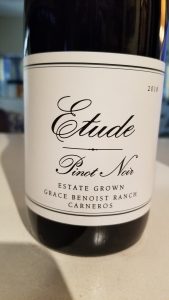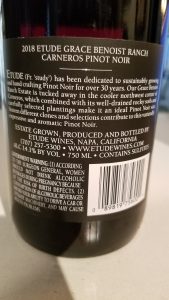Often when we are in a winery’s tasting room, we ask the servers to show us the bottle. Of course, it’s not the bottle we want to see; they’re all pretty much the same. (Actually, that’s not true. There are Bordeaux bottles with round shoulders and Burgundy bottles with sloping ones.) What we really want to see is the label, or actually two labels: one on the front of the bottle and one on the back.
The servers usually look at us quizzically. “Why?” they seem to be asking, but they do anyway?
So here’s the answer to their question and some advice on how you can take advantage of the labels as well.
- The look of the label tells you something about the wine. Great wines don’t need silly labels. A classic label gives us an idea of the winery’s owners’ approach to making wine. A picture of the château or some great art are fine, but a lot of bright colors or unusual type scripts generally indicate that they’re more interested in catching your eye in a shop than letting the wine’s reputation speak for itself.
- You can ignore a lot that’s on the label. It contains some warnings that you’re not interested in, such as the fact that the wine contains nitrates (they all do) and that you shouldn’t drink and drive (you already know that). You’ll learn the winery’s address, amount of wine in the bottle and the URL of their web site. None of this is very important to you but the government insists on it.
- Look for the interesting information. The label should tell you the name of the winery. On top of telling you the kind of wine (Pinot, Cabernet, etc.), it might tell you the name of the wine, such as the “Private Reserve” or “My Zin”. If they care enough to name their wines, it might indicate that this wine is intended to be rather special. Even more so, some better wines come from single vineyards and they name that location. By itself, all this data may not mean much, but put together these are all indicators that the contents of the bottle may be something special. And it it’s not there, that tells you something, too. (Maybe that’s not the winery’s best wine).
- Check one number in particular. Perhaps most important information on the label is the amount of alcohol in the wine. If you’re driving from winery to winery to taste their products, this will help you calibrate your consumption. For a long time, 12.5% or 13% was the norm. Now anything less than 14% is considered light. Moreover, the alcohol level tells you a lot about wine itself. While there are some exceptions, any wine that contains more than 14.5% is likely to be “hot”, tasting of alcohol rather than grapes.
- Some labels tell a story. It may or may not be an interesting story. Some tell the history of that particular wine. Those on the wines from Ridge winery, for example, give a detailed explanation of the growing condition, the soil, and everything but the name and address of the person who picked the grapes. And some just tell you whatever the Marketing department felt like saying.
So why do we ask to see the label when we’re wine tasting? Because it makes us more informed about what we’re sipping and what we might be buying.

